Related Research Articles

Looney Tunes is an American animated franchise produced and distributed by Warner Bros. It began as a series of short films that originally ran from 1930 to 1969, concurrently with its partner series Merrie Melodies, during the golden age of American animation. Following a revival in the late 1970s, new shorts were released as recently as 2014. The two series introduced a large cast of characters, including Bugs Bunny, Daffy Duck, and Porky Pig. The term Looney Tunes has since been expanded to also refer to the characters themselves.

Leon Schlesinger was an American film producer who founded Leon Schlesinger Productions, which later became the Warner Bros. Cartoons studio, during the Golden Age of American animation. He was a distant relative of the Warner Brothers. As head of his own studio, Schlesinger served as the producer of Warner's Looney Tunes and Merrie Melodies cartoons from 1930, when Schlesinger assumed production from his subcontractors, Harman and Ising, to 1944, when Warner acquired the studio.

Bosko is an animated cartoon character created by animators Hugh Harman and Rudolf Ising. Bosko was the first recurring character in Leon Schlesinger's cartoon series and was the star of thirty-nine Looney Tunes shorts released by Warner Bros. He was voiced by Carman Maxwell, Johnny Murray, and Billie "Buckwheat" Thomas during the 1920s and 1930s and once by Don Messick during the 1990s.

Isadore "Friz" Freleng, credited as I. Freleng early in his career, was an American animator, cartoonist, director, producer, and composer known for his work at Warner Bros. Cartoons on the Looney Tunes and Merrie Melodies series of cartoons from the 1930s to the early 1960s. In total he created more than 300 cartoons.

Hugh Harman was an American animator. He was known for creating the Warner Bros. Cartoons and MGM Cartoons studios and his collaboration with Rudolf Ising during the Golden Age of American animation.
Hugh Harman and Rudolf Ising were an American animation team and company known for founding the Warner Bros. and Metro-Goldwyn-Mayer animation studios. In 1929, the studio was founded under the name "Harman-Ising Productions", producing Looney Tunes and Merrie Melodies for Leon Schlesinger from 1930 to 1933. From 1934 to 1938, Harman-Ising produced the Happy Harmonies series, with William Hanna as their employee.

Merrie Melodies is an American animated comedy short film series distributed by Warner Bros. Pictures. It is the companion series to Looney Tunes, and featured many of the same characters as the former series. It originally ran from August 2, 1931, to September 20, 1969, during the golden age of American animation, though it had been revived in 1979, with new shorts sporadically released until June 13, 1997. Originally, Merrie Melodies placed emphasis on one-shot color films in comparison to the black and white Looney Tunes films. After Bugs Bunny became the breakout character of Merrie Melodies and Looney Tunes transitioned to color production in the early 1940s, the two series gradually lost their distinctions and shorts were assigned to each series randomly.

Buddy is an animated cartoon character in the Looney Tunes series by Leon Schlesinger Productions. He was the second star of the series, after Bosko.
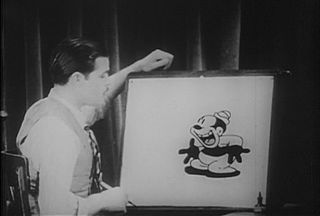
Rudolf Carl Ising was an American animator best known for collaborating with Hugh Harman to establish the Warner Bros. and MGM Cartoon studios during the early years of the golden age of American animation. In 1940, Ising produced William Hanna and Joseph Barbera's first cartoon, Puss Gets the Boot, a cartoon featuring characters later known as Tom and Jerry.

Foxy is an animated cartoon character featured in the first three animated shorts in the Merrie Melodies series, all distributed by Warner Bros. in 1931. He was the creation of animator Rudolf Ising, who had worked for Walt Disney in the 1920s.
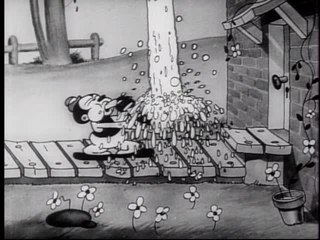
Sinkin' in the Bathtub is the first Warner Bros. theatrical cartoon short as well as the first of the Looney Tunes series. The short debuted in April 1930, at the Warner Bros. Theater in Hollywood. The cartoon features Bosko, and the title is a pun on the 1929 song Singin' in the Bathtub. The film was erroneously copyrighted under the same title as the 1929 song. It is now in the public domain in the United States as the copyright was not renewed.
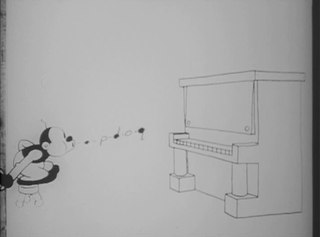
Bosko, the Talk-Ink Kid is a 1929 live-action/animated short film produced to sell a series of Bosko cartoons. The film was never released to theaters, and therefore not seen by a wide audience until 2000 on Cartoon Network's television special Toonheads: The Lost Cartoons. The film was produced on May 29, 1929 and directed by Hugh Harman and Rudolf Ising.
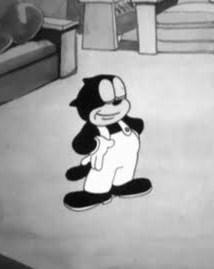
Beans the Cat is an animated cartoon character in the Warner Bros. Cartoons series of cartoons from 1935–1936. Beans was the third Warner Bros cartoon character star after Bosko and Buddy. He is voiced by Billy Bletcher and occasionally by Tommy Bond. He was created by director Friz Freleng. The character was featured in nine cartoons made in 1935 and 1936.
Warner Bros. Cartoons, Inc. was an American animation studio, serving as the in-house animation division of Warner Bros. during the Golden Age of American animation. One of the most successful animation studios in American media history, it was primarily responsible for the Looney Tunes and Merrie Melodies series of animated short films. The characters featured in these cartoons, including Bugs Bunny, Daffy Duck, and Porky Pig, are among the most famous and recognizable characters in the world. Many of the creative staff members at the studio, including directors and animators such as Chuck Jones, Friz Freleng, Robert McKimson, Tex Avery, Robert Clampett, Arthur Davis, and Frank Tashlin, are considered major figures in the art and history of traditional animation.

Hold Anything is the third short in the Looney Tunes series from Warner Bros., released to theaters in October 1930. Featuring Bosko, it is loosely based on the lost film Hold Everything, one of whose songs, "Don't Hold Everything," features prominently in the cartoon. It was directed by Hugh Harman and Rudolf Ising, and animated by Isadore "Friz" Freleng and Norman Blackburn.

Hittin' the Trail for Hallelujah Land is a 1931 Warner Bros. Merrie Melodies animated cartoon directed by Rudolf Ising. The short was released on November 28, 1931, and stars Piggy.
Ride Him, Bosko! released in 1932, is a Western animated short film in Warner Bros.' Looney Tunes series. It features Bosko, Warner Bros.' first cartoon character and his sweetheart Honey in the Old West.
Bosko's Parlor Pranks is a 1934 Happy Harmonies cartoon produced by Hugh Harman and Rudolph Ising for Metro-Goldwyn-Mayer starring their character Bosko. It is the first Bosko cartoon produced in color, and the first made at MGM following the Harman-Ising studio ending its deal to produce Looney Tunes and Merrie Melodies for Warner Bros. and Leon Schlesinger. Warner Bros. would later own Happy Harmonies and the MGM cartoon studio through its Turner Entertainment Co. banner.
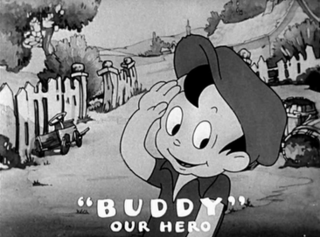
Buddy's Day Out is a 1933 Warner Bros. Looney Tunes cartoon, directed by Tom Palmer. The short was released in theaters on September 9, 1933, premiering with Goodbye Again, and was the first cartoon to feature Buddy, the second star of the series who was created by Earl Duvall.

Bosko's Holiday is a one-reel 1931 short subject animated cartoon, part of the Bosko series. It was directed by Hugh Harman, and first released on July 18, 1931 as part of the Looney Tunes series from the Leon Schlesinger animation studio and distributed by Warner Brothers. The film score was composed by Frank Marsales.
References
- ↑ Beck, Jerry; Friedwald, Will (1989). Looney Tunes and Merrie Melodies: A Complete Illustrated Guide to the Warner Bros. Cartoons. Henry Holt and Co. p. 22. ISBN 0-8050-0894-2.
- ↑ Lenburg, Jeff (1999). The Encyclopedia of Animated Cartoons. Checkmark Books. pp. 57–58. ISBN 0-8160-3831-7 . Retrieved June 6, 2020.
- 1 2 3 4 5 6 7 8 9 10 11 12 13 14 15 Brian Cruz (2000–2003). "Bosko's Picture Show". Toon Zone LLC. Archived from the original on February 8, 2012. Retrieved December 11, 2013.
- ↑ Grob, Gijs (August 23, 2017). "Bosko's Picture Show". Dr. Grob's Animation Review. Retrieved February 13, 2023.
- 1 2 Cohen (2004), p. 15
- ↑ Birdwell (1999), p. 5-34
- 1 2 Shull, Wilt (2004), p. 30
- ↑ Welky (2008), p. 41-42